Following Survival of the Fittest’s victory at
StarCityGames.com Legacy Open: Richmond
, the archetype had cemented itself as king of Legacy. All kingdoms crumble, however, and so too did this one. With Survival of the Fittest having met
its well-deserved fate, Legacy was left with a gaping hole in the middle of the metagame — but that didn’t last long.
One of the most unique things about Legacy is that many players stick to what they like, regardless of others’ urgings or new decks that pop up along
the way. That meant a return to business as usual for a lot of players. Alex Bertoncini has been jamming Merfolk for years now, and most CounterTop aficionados are the
same way — they stick to what they know, and it pays off.
Once players had rubbed the scorching light of freedom out of their eyes, they discovered that the world had returned to normal.
As before and ever, this chart excludes decks that occupied less than 1% of the field, and mirror matches have been removed from the equation – or right-click here to download the full spreadsheet:
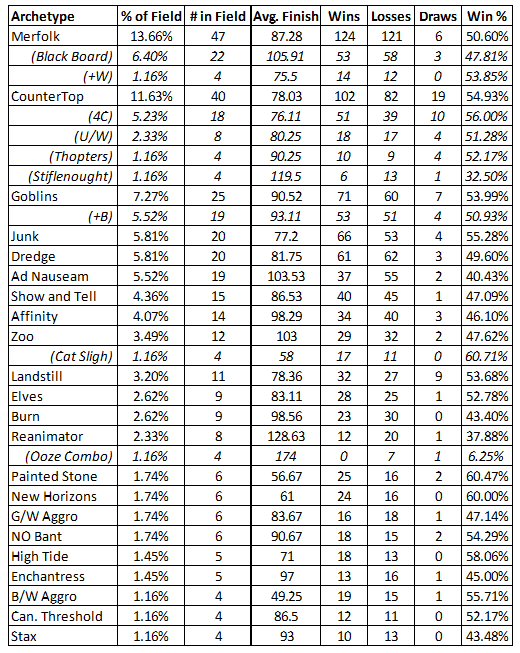
Looks familiar, am I right? The only real change from the pre-Survival metagame has been the introduction of Time Spiral, which has thus far been
relatively quiet. High Tide made a minor splash in Kansas City and saw a
few players in San Jose, but the
archetype hasn’t found its footing just yet. The top decks are the same big guns, while the rest of the field remains diverse. I’ve been taking a crash
course in Legacy over the last couple months, having not had the chance to learn it until now — and it has a very peculiar metagame.
This amazing variety actually makes our data less reliable. With fewer people piloting the most popular archetypes, our matchup percentages
will be more likely to skew due to variance and pilot error. With so many unique versions and splashed colors in other decks, generalized matchup
advantages should also be taken with a major grain of salt. It’s not unusual for the addition or subtraction of a single card or color to change a
matchup from huge favorite to slight underdog, due to the power level and card selection available.
All that said, there’s still a lot to learn from this information, and Indianapolis approaches. Onward!
Merfolk — 13.66% of the Field — Won 50.60% of Matches
Best finish: Corbin Hosler — Second place, StarCityGames.com
Legacy Open: Kansas
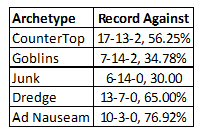
Fish is an elder statesman of Legacy, one of the oldest archetypes in the format — and one of the most misunderstood. The deck has plenty of aggression
and a lot of counter backup. It can grind you out with massive, unblockable threats, controlling the game via attrition and Standstills until you find
yourself buried by seamen. The variations splashing black have grown quite dominant following Saito’s win in Columbus, and yet they are inexplicably
underperforming the white variants on the numbers.
U/B Merfolk appeared in both Open Top 8s, with another Top 16 performance. Taking a closer look, it seems that when a U/B Merfolk player whiffs, they
whiff hard — the players who failed to post significant finishes were often eliminated early on, dragging the percentages down. The plain old blue
version also had a fine showing, splitting a Top 16 and a Top 8 in San Jose. The numbers on the white deck may have been skewed by early losses
preceding later wins, boosting their percentage up as players slugged through the rest of the rounds. With a smaller sample size, that tweaks the
numbers up.
You get what you pay for with Merfolk, at least — dismal matchups against Junk and Goblins, and fine ones against CounterTop and combo.
CounterTop — 11.63% of the Field — Won 54.93% of Matches
Best finish: Gerry Thompson — Second place, StarCityGames.com
Legacy Open: San Jose
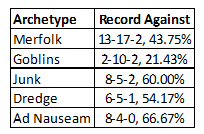
Goblins and Merfolk dominated Kansas City, but CounterTop showed up with a vengeance in San Jose — it’s almost like the players wanted to prove Kansas
City wrong. Well, they certainly didn’t do that!
CounterTop’s awful margins against the top tribal decks in the format held, and even GerryT could not overcome Iain Bartolomei’s Goblins in the finals. On the plus side,
CounterTop’s margins against control and Junk are all quite strong, and it’s a great deck against other random contenders like High Tide. A lot of top
players favor the deck due to the high amount of flexibility and card selection available, guaranteeing players a chance to play some Magic.
Note that this is another Legacy deck beating half of the top six decks while losing to the remaining two — and of course, flipping coins in the
mirror. There are a lot of flavors of CounterTop available — beyond the successful percentages posted by 4-Color, U/W, and Thopters, AJ Sacher also managed to dominate Kansas City with a Natural
Order build before being dispatched by Fish. While he still cites Merfolk as a bad matchup, I can’t
help but wonder if his Wall of Roots and Progenitus improve the Goblins pairing. Having more fours to counter Ringleader seems quite relevant, as well.
Goblins — 7.27% of the Field — Won 53.99% of Matches
Best finishes: Chris Osinski — First place, StarCityGames.com
Legacy Open: Kansas; Iain Bartolomei — First place,
StarCityGames.com Legacy Open: San Jose
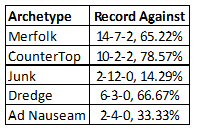
What can I say about Goblins that hasn’t been said already? The deck is very strong, and it punishes loose keeps and any opposing stumbles, which is
very valuable. If you aren’t prepared to stop a turn 1 Lackey, the game may be over before it begins. If your mana comes out shaky, Wastelands and
Rishadan Ports will ensure that you fall behind. The deck is consistent and robust, with card advantage via Ringleader and selection available through
Matron.
Plus, it’s an Aether Vial deck in a format where many of the best players love CounterTop. It may not even be the best Vial deck, but it’s a good one.
It’s easy to see why Goblins triumphed in Kansas City and San Jose — the deck’s two best matchups were the only decks more popular than Goblins itself!
With Ad Nauseam posting pathetic numbers, Goblins players have just one deck left to fear.
Junk — 5.81% of the Field — Won 54.92% of Matches
Best finish: Shai Shaham — Third place, StarCityGames.com Legacy
Open: San Jose
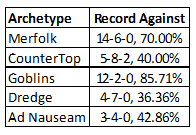
But fear it they should! While fourteen matches is only a handful, I think anyone comparing the decks side-by-side would see that Junk has what it
takes to roll the Goblin tribe consistently.
The problem? Junk’s just not broken enough. It’s the first deck on our list to lack three favorable pairings, making it a risky choice against a wider
field. The Counterbalance matchup is tight but winnable, while the combo decks rely on Junk failing to find a glut of disruption. Michael Jacob tournament report from Kansas City might
also be helpful to aspiring pilots of the archetype—it details his cruise to a tenth-place record following a single loss to Ad Nauseam.
I like Junk a fair bit in this field — it’s a strong deck that plays some of the best cards in the format, and it’s not as intricate as Counterbalance
or as single-minded as Goblins and Merfolk. Junk performed admirably in both Opens, but still fell short. It’s possible that the deck will continue to
be a metagame bridesmaid, but the right modifications could change one player’s fortunes for a single weekend.
Dredge — 5.81% of the Field — Won 49.60% of Matches
Best finish: Caleb Neufeld — Fourteenth place, StarCityGames.com
Legacy Open: San Jose
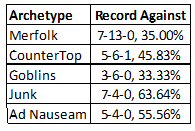
I love me a Dredge deck, but it’s pretty hard to advocate running it with these numbers. The three most popular decks are all bashing you pretty good.
You’re also not tricking anyone — no one in Legacy wakes up one morning and decides that their graveyard hate isn’t worth it, as they have in past
Extended formats. There are enough decks that abuse the graveyard in this format to guarantee that even a dip in Dredge’s popularity won’t earn many
free wins against unprepared opponents.
Even the deck’s favorable edges aren’t very convincing, and Junk has access to the tools it needs to beat this monster—most players are satisfied to
skirt the minimum, but that could change at any time. My advice is to stay away for now.
Don’t forget about Dredge, though. It’s the sort of deck that could be revitalized by a single card or interaction at any moment.
Ad Nauseam — 5.52% of Field — Won 40.43% of Matches
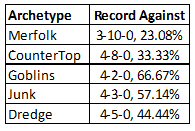
I believe that Ad Nauseam is a strong deck — I do. But each game tends to be quite one-sided, and it has a nasty case of glass cannon syndrome. People hate losing to Ad Nauseam, and many sideboards are
built with the combo deck in mind. Potent matchups against decks without counterspells are nice and all, but Merfolk and Counterbalance are the two
most popular decks in the field. Can anyone really expect to dodge or lucksack enough of them to climb to the top? The sample size on this deck is
small for a reason — few people played it, and the ones that did got bashed early on.
Of course, if you want to guarantee yourself a lunch break, Ad Nauseam is the first deck we’ve discussed that recorded zero draws over both
events. So there’s that.
Moving on, we have a couple other archetypes that caught my eye. There’s a good chance they should be catching yours, as well.
Painted Stone — 1.74% of the Field — Won 60.47% of Matches
Best finish: Nick Spagnolo — Fifteenth place, StarCityGames.com
Legacy Open: San Jose
I don’t get to play in many — well, any — Legacy Opens. If I did, this would be the deck I’d play. It just looks like so much fun!
The deck has a lot of cute interactions aside from the actual combo, such as using Grindstone to rest your Sensei’s Divining Tops or Brainstorms.
Painter’s Servant makes Pyroblast and Force of Will better, and the sideboard has the spiciest of meatballs — Show and Tell plus Emrakul, the Aeons
Torn. The deck is already built to efficiently assemble two combo pieces, so changing which ones you snag just makes life harder on the opponent.
While this deck’s performance has mostly just been Spagnolo, Mike Pozsgay, and Caleb Durward jamming it into Open after Open, their win percentage is
quite reasonable. I’d take some time to master this sword before taking it into combat, but the archetype itself has been battle-tested already. If
they keep playing it, odds are one of them will have a breakout finish — and soon.
High Tide — 1.45% of the Field — Won 58.06% of Matches
Best finish: Jacob Baugh — Thirteenth place, StarCityGames.com
Legacy Open: Kansas City
Most players reacted with total apathy to the unbanning of Time Spiral in Legacy. That’s fair — it’s hard to justify a pseudo-Timetwister that risks
filling your opponent’s hand with answers when you can just play Ad Nauseam and kill your opponent… and that isn’t even good right now. Yet
High Tide’s ability to play its own counterspells, combined with the Cunning Wish toolbox, has thus far made it a reasonable contender.
I did a brief Deck Tech with Jacob Baugh in between rounds at
the Kansas City Open,
and it turned out that he’d been trying to break High Tide before Time Spiral even came back — how lucky! A dismal Counterbalance matchup is nothing to
write home about, but the deck can beat Merfolk and isn’t much different from Ad Nauseam in its other pairings. If you want to play combo, I’d take a
look at refining High Tide.
That’s the state of Legacy as Indianapolis looms. All of our shows in Indy tend to be enormous, and I’m hoping that the players are looking to break
some attendance records this year. SCGLive.com will be broadcasting the event with Jacob Van Lunen and Adrian
Sullivan commentating, while I’ll be churning out written coverage like a human printing press from Round 1 onward. Our live feed will cover every
round of the Legacy Open, so tune in early and get comfortable — it’s going to be a great tournament!
Glenn Jones
Coverage Content Manger
